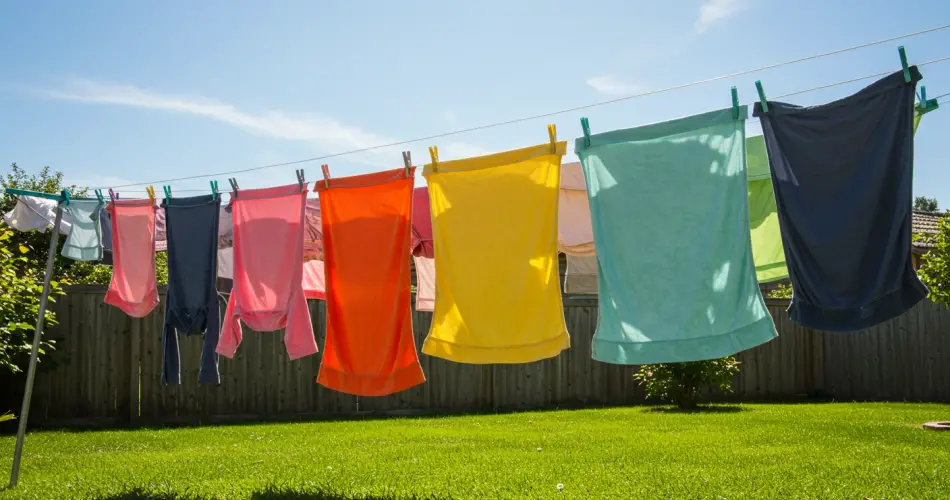Over time, even the most beloved household items can lose their original charm. One common example is the white resin clothes drying rack. While practical, durable, and resistant to water, these racks often develop a yellowed or dull appearance, particularly after months of exposure to sunlight and the elements. Fortunately, there is a simple and effective solution using a common kitchen ingredient: white wine vinegar. In this article, we will explore how to restore your drying rack to its former glory and keep it looking pristine.
Why White Resin Drying Racks Yellow
White resin drying racks are popular for many reasons. Compared to metal racks, they are sturdy, with thicker rods that reduce the annoying marks that clothes pegs can leave on garments. They also resist rust, unlike metal racks, which can corrode over time due to water, humidity, or prolonged contact with wet laundry.
However, despite their durability, white resin racks have one vulnerability: yellowing and darkening over time. The sun’s UV rays, dust, and environmental exposure contribute to this discoloration. During summer months, when racks are frequently placed outdoors to take advantage of sunlight and wind for faster drying, yellowing is particularly noticeable.
This discoloration isn’t just a cosmetic issue—it can also affect the cleanliness of your laundry. While it won’t rust like metal, dirt, dust, and accumulated residues can leave stains or dull spots on your clothes if the rack isn’t cleaned properly. Fortunately, regular maintenance and a simple household ingredient can reverse this yellowing and restore the rack to its original white.
The Advantages of Resin Racks
Resin drying racks are favored for several reasons:
-
Durability: Resin is resistant to water and won’t rust like metal, making it ideal for outdoor use.
-
Sturdiness: The thicker rods support heavier loads without bending, unlike some lightweight metal racks.
-
Ease of Use: Resin racks are easy to move and usually collapsible, offering flexibility in both indoor and outdoor spaces.
Despite these advantages, the aesthetic issue of yellowing remains, which can make even a sturdy, practical rack look old or neglected. But restoring its bright white color is easier than most people think.
White Wine Vinegar: A Simple Solution
One of the most effective and inexpensive solutions for cleaning yellowed resin is white wine vinegar. Beyond its culinary uses, vinegar is a powerful household cleaner. It has excellent degreasing, stain-removing, disinfecting, and odor-neutralizing properties, making it a versatile tool for many cleaning tasks.
For yellowed resin racks, vinegar works by breaking down the residues and oxidation that cause discoloration. With minimal effort, it can bring the rack back to its original bright white, making it look nearly new again.
Step-by-Step Guide to Cleaning Your Drying Rack
Step 1: Remove Dust and Loose Dirt
Before treating the rack with vinegar, start by wiping it down with a soft, damp cloth. Pay attention to all corners and joints where dust may accumulate. This step ensures that dirt doesn’t interfere with the cleaning process and allows the vinegar to work directly on the yellowed resin.
Step 2: Apply White Wine Vinegar
Soak a soft cloth or sponge in white wine vinegar and carefully wipe down each rod and part of the drying rack. The vinegar will start to dissolve stains, yellowing, and any residues on contact.
If certain areas are particularly stubborn or hard to reach, use a small brush or toothbrush dipped in vinegar to scrub gently. This will help remove buildup in joints, grooves, and textured areas that are difficult to reach with a cloth alone.
Step 3: Let It Sit and Repeat if Necessary
For racks with severe yellowing, it may take a few passes to fully restore the white color. After the initial wipe-down, let the vinegar sit on the surface for a few minutes, then wipe again. The chemical properties of vinegar will gradually lift the yellowed layer.
Step 4: Rinse and Dry
Once the yellowing has been removed, rinse the rack with clean water to eliminate any vinegar residue. Then, dry thoroughly with a soft cloth or allow it to air dry. Your drying rack should now look significantly brighter and cleaner.
Maintaining a White Resin Drying Rack
To prevent yellowing in the future, consider these maintenance tips:
-
Regular Cleaning: Wipe down the rack at least twice a month with a damp cloth or vinegar solution.
-
Avoid Prolonged Sun Exposure: While sunlight helps dry clothes faster, long-term exposure accelerates yellowing. If possible, place the rack in a partially shaded area.
-
Protect Against Dust and Residues: Indoor storage or covering the rack when not in use can reduce buildup from dust, moisture, and environmental pollutants.
Why This Method Works
White wine vinegar is acidic, which allows it to break down mineral deposits, dirt, and oxidation that contribute to yellowing. Its natural cleaning power makes it a safe, eco-friendly alternative to harsh chemical cleaners. Plus, it’s inexpensive and readily available in most households.
Unlike abrasive cleaners or harsh chemicals that might damage resin over time, vinegar is gentle yet effective. With regular care, your drying rack can maintain its original white appearance for years, ensuring your laundry looks clean and bright as well.
Conclusion
A yellowed drying rack doesn’t mean it’s time to buy a new one. With white wine vinegar, you can restore even the most discolored resin racks to their original pristine condition. This simple method is cost-effective, safe, and easy to implement.
By following a few simple steps—dusting, applying vinegar, scrubbing hard-to-reach areas, and rinsing—you can enjoy a clean, bright drying rack that looks almost new. Regular maintenance ensures that it stays white longer, protecting both the rack and your laundry from unwanted stains.
Next time your resin drying rack starts to yellow, reach for white wine vinegar, and watch it transform before your eyes. Simple, effective, and practical—the timeless power of vinegar proves once again that some household solutions are classics for a reason.



